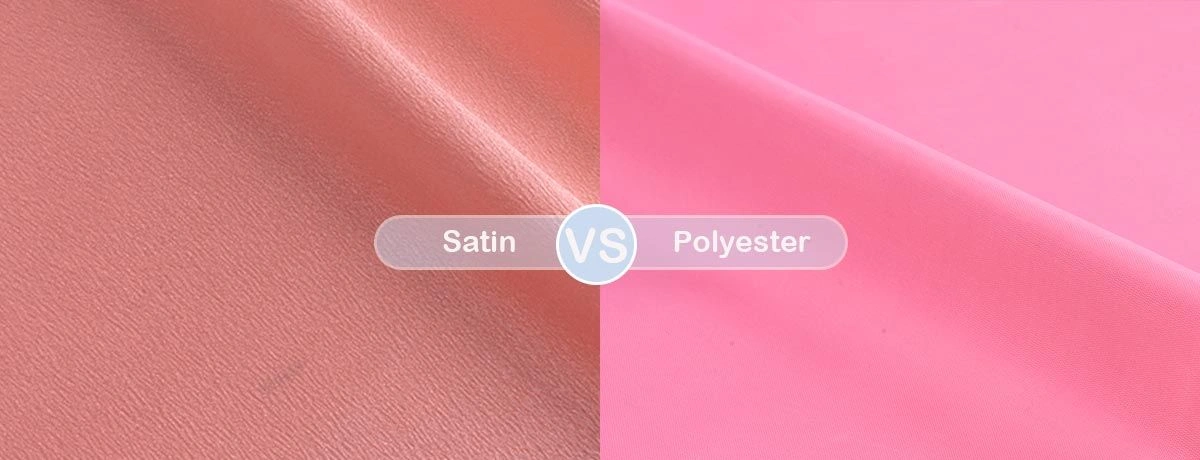Satin vs Polyester: Comparing Fabrics

Fabric selection is key to product quality and customer satisfaction in the textile industry. Polyester and satin are two of the most popular choices, each with its own characteristics. This post will help fabric wholesalers, sewing fabric suppliers, garment factories and home textile manufacturers make informed decisions.
1. Polyester and Satin Fabrics
Polyester and satin are often used interchangeably as they are used for the same applications; but they are fundamentally different. Polyester is a synthetic fabric derived from petroleum, while satin is a weave, not a fiber. This is the basis of the difference between satin and polyester.
2. What is Satin Fabric?
Satin fabric is renowned for its smooth, shiny surface and soft texture, making it a popular choice for luxurious applications. Unlike polyester, which is a type of synthetic fiber, satin refers to a specific weave pattern that can be made from various materials, including silk, polyester, and other synthetic fibers. This unique weave creates a glossy finish on one side and a duller surface on the other, giving satin its distinctive look and feel.
Satin fabric is often used in evening wear, bedding, and home decor due to its elegant appearance and tactile appeal. Whether it’s a silk satin gown that drapes beautifully or polyester satin bed sheets that add a touch of glamour to a bedroom, satin’s versatility and aesthetic qualities make it a favorite in the textile industry. The choice of fiber—be it natural silk or synthetic polyester—affects the fabric’s price, feel, and durability, allowing manufacturers to select the best option for their specific needs.
2. Polyester Fabrics Features
Polyester is a man-made fabric known for its durability, wrinkle resistance, and versatility. It is often used in a satin weave, which creates a smooth and glossy surface, making it a popular choice for shiny fabric applications. It is made from petroleum-based products, which makes it strong and long-lasting. Because of its toughness, polyester is the preferred choice in industries that require heavy-duty materials.
Polyester Advantages: Polyester Fabric
-
Durability: Polyester fabric is known for its durability, being stretch and shrink resistant.
-
Moisture Resistance: Quick drying and water resistant.
-
Affordability: Generally cheaper to produce and buy.
3. Satin Fabrics Features
Satin, unlike polyester, is defined by its weave and includes types such as synthetic satin. It is known for its luxurious, glossy surface and smooth texture. Satin can be made from various fibers like silk, nylon, or polyester, each affecting its feel and price. Satin's shiny finish is particularly suited for items such as evening bags, which adds a touch of elegance and style, reflecting the luxurious nature of the fabric.
Satin Advantages: Shiny Fabric
-
Aesthetic: Shiny fabric with a beautiful, lustrous finish.
-
Soft: Smooth and gentle to skin.
-
Versatile: For apparel, upholstery and decor.
Production and Composition of Synthetic Fiber
One of the main differences between satin and polyester is their production. Polyester, a synthetic fibre, is composed of long chains of synthetic polymers. Satin, on the other hand, is a weave that produces a specific fabric finish. Polyester satin is a combination of both, polyester fibers woven in a satin pattern. Despite being synthetic, polyester can resemble silk in appearance and texture.
5. Uses in Textile Industry
Both polyester and satin have their own uses:
-
Polyester is used in clothing, home textiles and industrial applications due to its durability and affordability.
-
Satin is used in evening wear, lingerie and decorative items where visual appeal is key.
6. Price and Market
The price and demand of polyester and satin is vastly different. Polyester's affordability makes it popular in bulk production, satin's luxury appeal is for high end market. Understanding this is important for businesses to plan their production budget and target market.
7. Environmental Impact and Sustainability
Polyester has a big environmental footprint due to its fossil fuel origin. It is also not a breathable fabric compared to natural fibers like silk. But recycling initiatives are improving its sustainability. Satin’s impact depends on the fiber used, natural fibers like silk is more eco friendly than synthetic fibers.
8. Conclusion: Choose the Right Fabric for Your Needs
Choosing between polyester and satin depends on the application, budget and requirements. For heavy duty and affordable polyester is the way to go. For luxury and aesthetic satin is unbeatable. By knowing the difference textile professionals can make informed decisions that suits their business.
So there you have it, polyester and satin has its own uses in textile industry, knowing their differences will help you make the right choice.
